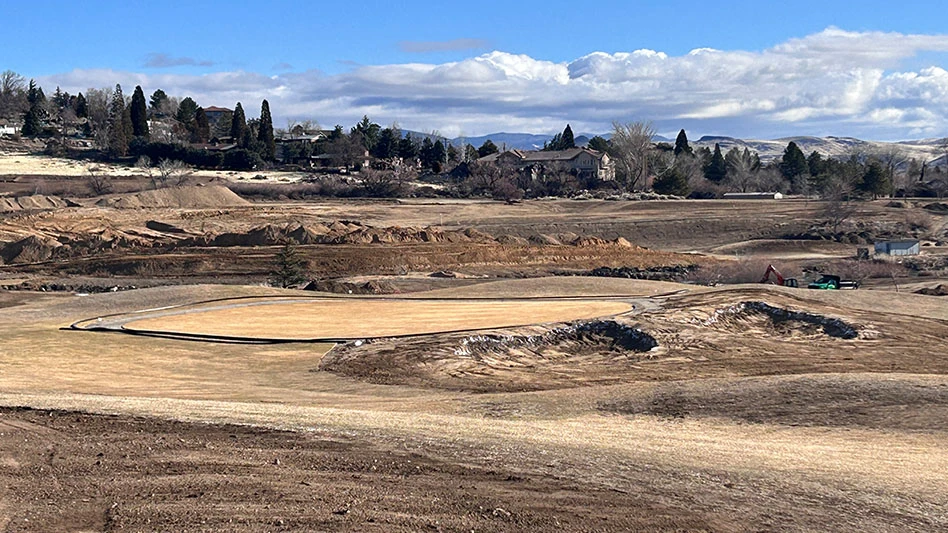
Developing a fungicide means displaying extreme patience. Test. Wait. Test some more. Wait some more. The process doesn’t always mesh with a society tilted toward instant gratification.
For the last 10 years, the Nufarm/Valent fungicide Pinpoint has been tested on university research plots for dollar spot control. The fungicide has received approval for use in Canada and is still awaiting EPA registration. Pinpoint is the first new fungicide introduced by Nufarm/Valent since the companies announced a collaborative agreement in 2014. “When it takes 10 years for something to come out, there’s a huge investment before one package is even sold,” The Ohio State University turfgrass pathologist Joe Rimelspach says. “A lot of leg time goes into it.”
GCI recently visited the Ohio Turfgrass Foundation Research and Education in Columbus, Ohio, to meet with Nufarm and Valent representatives, discuss the fungicide with Rimelspach and Ohio State colleague Todd Hicks, and observe test plots. Pinpoint targets dollar spot on greens and fairways and its active ingredient mandestrobin represents a newcomer to the golf industry. Mandestrobin belongs to the strobilurin class of fungicides. Pinpoint is the first strobilurin that doesn’t have to be used in combination with another fungicide to target dollar spot, according to Hicks.

Pinpoint has been tested under a variety of conditions at Ohio State, along with other universities and multiple golf courses, in the past decade. The Ohio State duo tested Pinpoint at 14-, 21- and 28-day intervals during mild, sticky and hot summers using the product at a rate of two gallons per 1,000 square feet.
“The nice thing about having multiple years is that we have done work from 14 up to 28 days,” Nufarm technical director Jason Fausey says. “Fourteen to 21 days for dollar spot is going to be our suggested program. I know some of those early spring applications were well over 21 days depending on the time and the pressure. Leaning on research and efficacy data, we like a 14- to 21-day interval.”
Pinpoint possesses preventative and curative activity, although Fausey says, “its strength is going to be the preventative activity.” Hicks sees the fungicide fitting nicely into a summer dollar spot control program.
“Two questions a superintendent asks … First, does it work? And, second, OK, now where do I use it?” Hicks says. “I like this chemistry because of the safety factor of using it in the summer. We have not seen any adverse effects no matter what the weather pattern is. In the middle of the summer from June 15 or 20 to about August 20 is what superintendents call ‘the survival zone.’ I get everything the way I want it by that period and I just try to maintain it as it slowly weans off and turns worse until I can grow it back. If you have something that gives protection and is safe to use, that’s a huge bonus for a superintendent.”
Tartan Talks No. 1

GCI and the American Society of Golf Course Architects are collaborating on a podcast series, “Tartan Talks,” exploring various trends in golf course architecture and development. Our first episode features Andy Staples, the President of Staples Golf.
We recorded the episode while touring Staples’ renovation work at Meadowbrook Country Club, a former PGA Championship site in suburban Detroit. Earlier this year, Staples released “The Community Links White Paper,” urging municipalities to either innovate or close struggling golf courses. Listen to the episode and Staples’ vision for municipal golf by entering bit.ly/29CChTb into your web browser.

Mending Lisa’s Heart
Fieldstone Golf Club, a Troon Golf managed private club featuring a Michael Hurdzan/Dana Fry course in Wilmington, Del., recently became the first golf course in the world to combine the synthetic sod wall and edge product Durabunker with the Better Billy Bunker liner product. The old-world bunkering at Fieldstone is a strong feature of the design with a number of sod-wall bunkers, the showpiece being the bunker on the 18th known as "Lisa's Heart" after club founder Lisa Dean Moseley. David Whelchel, the architect involved on site during the initial stages of the Durabunker project, was also a central figure in the original design with Hurdzan and Fry.
Still coping with fall flooding
Golf courses along the South Carolina coast are recovering from a second wave of issues stemming from devastating floods last fall. Saturated soils and cloudy skies induced a fungal disease that attacked Bermudagrass greens as they were moving into dormancy.
The resultant damage only became apparent when temperatures finally picked up after a mild spring. Instead of emerging with vigorous green growth from its cool-season hibernation, large swaths of Bermudagrass were dead.
Courses from Myrtle Beach to Hilton Head were affected with the Charleston area the worst hit. Similar damage also appeared in central and south Florida.
“I saw more catastrophic loss of putting greens grasses in the area from February to the end of May than I have seen in the last 25 years,” says United States Golf Association Green Section agronomist Patrick O’Brien. “Conditions were perfect for Pythium root rot. They couldn’t have been more ideal.”
Damage was widespread and did not discriminate between public or private facilities or between varieties of Bermudagrass. Loss of grass on some putting greens was as much 70 percent forcing golf course superintendents to make costly repairs.
Industry buzz
- Toro elected Richard M. Olson as CEO. Olson will replace Michael Hoffman effective Nov. 1. Hoffman will continue to serve as the chairman of the board.
- Bayer announced EPA registration for Exteris Stressgard. The formulation provides dollar spot, brown patch and leaf spot control while adding additional benefits such as dew mitigation and fast knock-down of damaging mycelium.
For more industry news, subscribe to GCI’s Fast & Firm enewsletter by entering bit.ly/2a2KmS8 into your web browser.

Explore the August 2016 Issue
Check out more from this issue and find your next story to read.
Latest from Golf Course Industry
- The Cabot Collection announces move into course management
- Carolinas GCSA raises nearly $300,000 for research
- Advanced Turf Solutions’ Scott Lund expands role
- South Carolina’s Tidewater Golf Club completes renovation project
- SePRO to host webinar on plant growth regulators
- Turfco introduces riding applicator
- From the publisher’s pen: The golf guilt trip
- Bob Farren lands Carolinas GCSA highest honor





